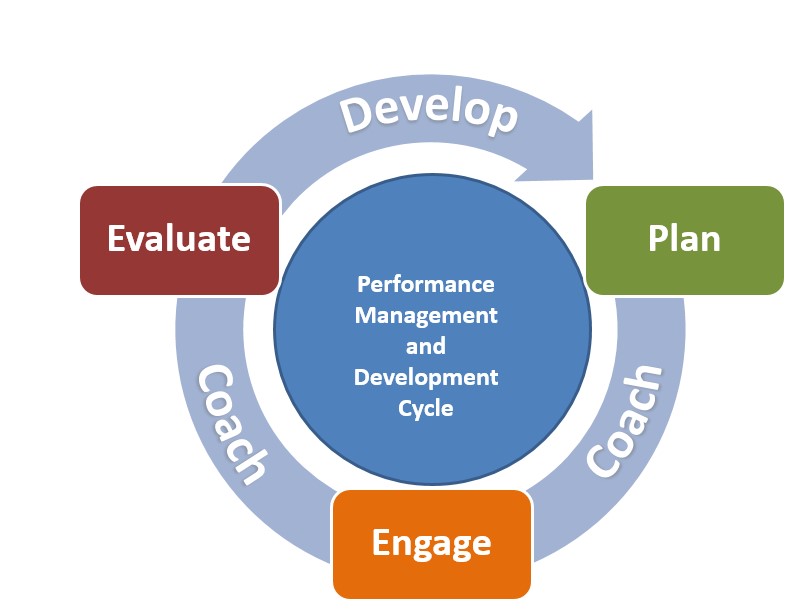
Step 1: Formulate KPA’s and developing a performance agreement for individual staff
The performance agreement has the following components:
A statement of performance areas. These are the major outcomes the staff member is expected to achieve over a period of 12 months.
Manager’s support. This requires the supervisor to specify how he/she will assist the staff member to achieve the performance results.
Learning and development plan. This specifies how the staff member will develop the skills required to achieve the performance results and to advance their personal career.
Performance evaluation. This includes the rating that represents the extent to which the staff member has achieved their performance results.
Career plan. An explanation of how this year’s performance and development relates to the overall career objectives of the individual.
Step 2: Formulate objectives
The next step is to formulate performance objectives that will lead to the achievement of the agreed KPA’s. For each KPA you could potentially have between 3 and 8 performance objectives. Objectives must be specific, measurable, achievable, realistic and time bound. We talk about SMART objectives:
Specific: What is the exact scope of the objective? What is included and what is not? What might be thought to be included but is being done by someone else?; What must be done with the outputs?
Measurable: What measures will be used to know that the objective has truly been reached? When and how often will the process be measured? What measurement tools can be used to determine success? What format must the output take?
Achievable: A delegated impossibility is still impossible! If there is doubt over whether the objective is achievable, then the first part of the process should be either to test feasibility or to identify what would have to be changed in order to make the rest feasible.
Realistic: What is a realistic task for a functional expert to undertake in a week, may not be realistic for a junior joiner in a month. A series of roll-out meetings might be scheduled in two weeks, but clashes with public and personal holidays could mean that a month will be required. The test for a good objective is that it always deals with the reality of how long it will take to do things, rather than how long we would like it to take if we could ignore inconvenient facts.
Time bound: An objective without a clear specification of its timing priority is likely to be put at the bottom of the list. It will not get done. The simplest way to ensure that an objective will be achieved is to agree on a realistic deadline, even for objectives that are not time critical for success.
Step 3: Consult and agree on performance standards with individuals and teams
The purpose of this discussion is to agree on goals and objectives and tracking methods. This is especially important because it sets a positive tone while you gain the person’s commitment to performance levels and participation in the process. People are most committed to achieving individual and departmental objectives when they play an active role in setting them and carrying them out.
To prepare them for involvement and to ensure their commitment, it is essential that they:
- Understand their role in the process.
- See how their KPA's and objectives are based on departmental and organisational goals and objectives.
- Receive coaching from their manager/supervisor when they develop their KPA's and objectives.
- Understand that they are responsible for tracking their own performance and choosing informative and reliable tracking methods.
Step 4: Provide feedback on performance
Feedback is the process according to which you receive information from the external environment on both the positive and negative aspects of your performance.
Feedback provides an answer to the question “How am I doing?"
Constructive feedback on performance is important because it encourages and motivates employees to perform at acceptable standards. It also helps correct mistakes and solve problems, it builds relationships between people, saves money, and provides direction. People taking part in a performance management process, both managers/supervisors and staff members, need to know how to provide constructive feedback to fellow employees as well as how to receive feedback in such a manner that it will have a positive effect on performance. Open and direct criticism provides the opportunity to clear misunderstandings and correct wrong perceptions and behaviour.
Timely Feedback: Provide feedback as soon as possible after an incident occurs. Feedback today on something that happened this morning means much more than feedback tomorrow or the following week. The incident is still fresh in the person’s mind, so feedback will be more meaningful.
Balanced feedback: Mix positive and constructive comments throughout the discussion where possible. Too much negative feedback might make people defensive and unwilling to communicate. If you recognise all the satisfactory performance in the beginning and leave the corrective feedback for the end, a person might feel ‘set up’. Disappointment and resentment might then replace any feeling of satisfaction. After giving corrective feedback, end the discussion with a plan for improving performance. Work closely with the staff member on the plan. The more the individual contributes to it, the more committed she will be to carry it out.
Specific Feedback: A vague comment, like “You could have done a better job on that report”, does not identify the problem. It does not indicate what was wrong and how to improve. It is not the type of feedback that will help someone achieve his or her objectives. Along the same lines, general praise like “You have done a good job on that report”, also does not specify what the individual die well and should continue doing. Specific feedback explains what the individual did and why it as effective or ineffective.